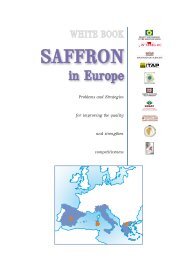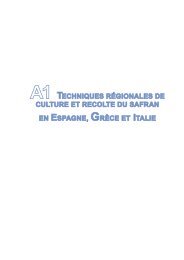A1.3 TRADITIONAL SAFFRON CULTIVATIONA1.3.1 Cycles. Rotation of cultivationIn the cycle of Fig. 2 there are two different stages within one year:the activity period and the dormant period. The activity period lasts fromAugust to September or from April to May. During this period the plantactivates again its metabolism while root penetration, sprouting, floweringand leaf growth take place (Lopez, 1989). During dormant period,the bulbs do not change in volume or weight because they are alreadyfully formed. There is a transitory period between these two periods, inwhich mitosis and differentiation occur, however to a less importantrhythm (Mylyaeva y Azizbekova, 1978; Azizbekova et al., 1978).Fig. 2 Annual cycle of Crocus sativus L. (Lopez, 1989)In Castile-La Mancha, the production period of saffron lasts threeto four years. Normally, the preferred fields are those where no clover,potatoes or carrots have been cultivated for the last 3 years (or othercultivations that may carry diseases common to Crocus sativus L.).On the contrary, in Western Macedonia, the production period lasts5 to 7 years. As soon as bulbs emerge, they are separated, cleaned andreplanted in another field allowing thus the soil to rest and regain all nutrientsthat were lost during saffron cultivation.In Sardinia the period of production lasts 4 years. Between twocultivation cycles there is an interval of 5 to 10 years. Traditionally, thecultivation of saffron is followed by legumes cultivations such as broadbeans, chickpeas and lentils by the use of fertilizers.98
A1.3.2 Soil preparation before plantingA1.3.2.1Soil treatmentIn Castile-La Mancha the main task consists in ploughing at a depthof 35 to 40 cm using discs or hydraulic mould board ploughs. Nevertheless,the procedure varies according to the region, the climate and thenature of the soil. March or April is generally suggested for this task, inorder to benefit from spring rains, but sometimes ploughing takes placein May or June, right before bulb planting. (De Juan et Lozano, 1991;Perez 1995). After the second hoeing a broad plank is used to flattenthe soil for planting (Vidal, 1986).In Western Macedonia, soil treatment consists in deep ploughing atalmost 30 to 35 cm only one month before planting, followed by a notso deep ploughing in order to help the soil absorb the fertilizer and alsoby harrowing, in order to break up clods and lumps and to provide afiner finish. Weeds and stones, as well as any other elements that couldinhibit natural bulb development, are removed.In Sardinia, summer ploughing takes place at a 30 to 40 cm depth.Even nowadays, in San Gavino Monreale horse – drawn ploughs arebeing used, although small motor ploughs or tractors are being used aswell. Trenching and harrowing take place after panting, using the sameequipment as before.A1.3.2.2 Organic and mineralized fertilizersIn Castile-La Mancha, during the preparatory year of the cultivation(year zero), fertilizing is recommended three months before planting,using 20 to 30 mg manure per hectare. This task is performed througha second hoeing at an average depth by adding mineralized fertilizers.The appropriate mixing period lies between May and June. The mixedamounts recommended are 40 – 50 kg of nitrogen per hectare in formof ammonium sulfate (21 % N2), 80 – 100 kg of phosphor per hectarein form of super phosphate (18 % P2O2) and 100 – 120 kg of potashper hectare in form of potassium sulphate (60 % K2O5) (Munoz, 1987;Perez 1995; ITAP, 1998).In Western Macedonia, no specified fertilizing strategy exists, due toorganic soil differences (structure and texture), climatic variations andspecific features of the preceded cultivation, but experience of the cultivator.In general and apart from organic cultivation, manure is avoidedin order to prevent weed spreading in the field.A mixed chemical fertilization is recommended (N-P-K) in accordancewith following formulas:a) 100 kg (11N-15P-15K) + 20 kg (0N-0P-5K) = 120 kg per hectareb) 60 kg (0N-20P-0K) + 40 kg (21N-0P-0K) + 50 kg (0N-0P-50K)=150 kg per hectare99




